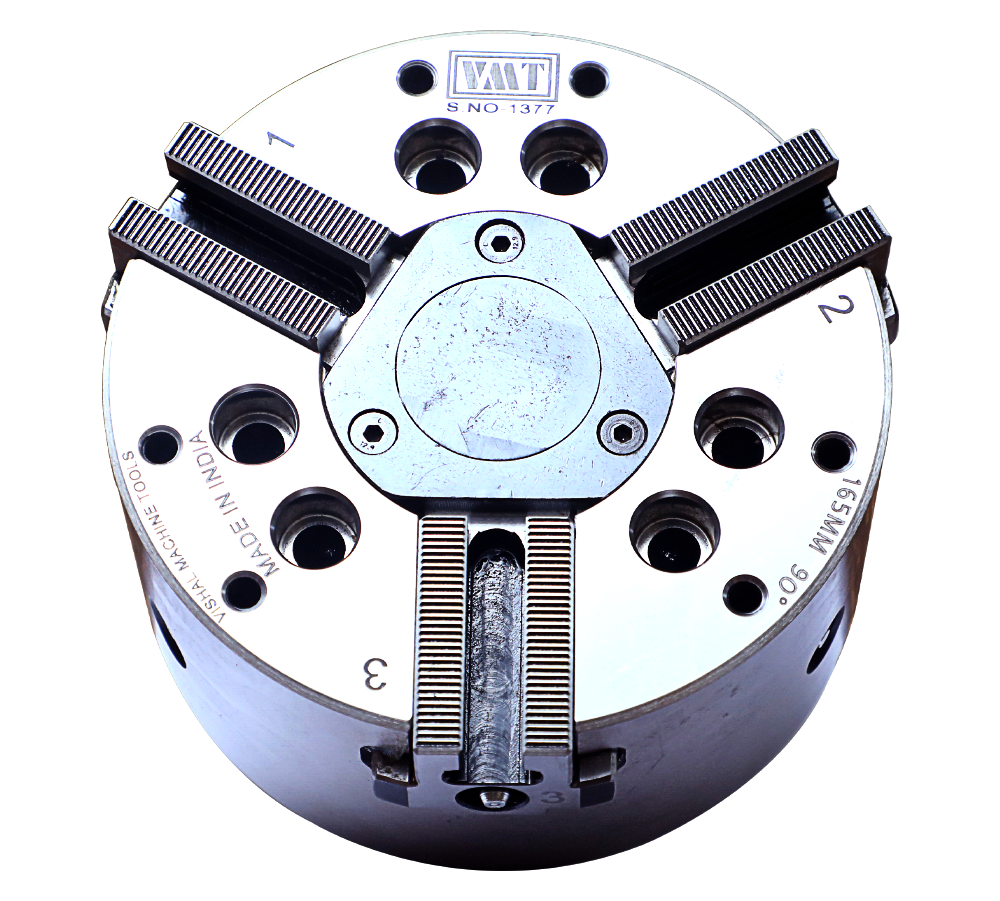The Core of Precision Machining: Hydraulic, Collet, and Power Chucks.
Hydraulic Chuck
A hydraulicchuck is a high-precision tool holder used predominantly for clamping
cutting tools on CNC milling centers. It excels in applications requiring
exceptionally low runout and excellent vibration damping.
Key Features & How It Works
- Mechanism: The
chuck body contains an internal chamber filled with hydraulic oil. When a
side-mounted set screw is tightened, it compresses the fluid. This
pressure forces a thin, internal sleeve to expand uniformly in a 360-degree
circle, clamping the tool shank with minimal runout (typically $\le 3\
\mu\text{m}$).
- Clamping Force: It
provides a moderate, uniform clamping force, which is double that
of a standard collet chuck but less than a mechanical milling chuck or
shrink-fit holder.
- Ideal Applications: Due to
their superior vibration damping and minimal runout, hydraulic
chucks are perfect for high-speed finishing operations like reaming,
drilling, and light finishing milling in industries like mold &
die, aerospace, and medical device manufacturing.
- Benefits: Quick
and simple tool changes (no external heating required), excellent
concentricity, and prolonged tool life due to reduced vibration.
Power Chuck
A powerchuck is a general term for a workpiece-holding chuck (used on lathes and
turning centers) that uses an external power source—typically hydraulic or pneumatic
pressure—to automatically open and close its jaws. They replace manual chucks
to automate the workholding process.
Types and Clamping Mechanism
- Hydraulic Power Chucks: These
use pressurized hydraulic oil from the machine's system to move a piston,
which, in turn, drives the clamping jaws. They generate the highest
clamping force, making them ideal for heavy-duty, aggressive machining
of large or tough workpieces (e.g., in automotive or heavy equipment).
- Pneumatic Power Chucks: These
use compressed air to actuate the jaws. They provide a lower, more
stable clamping force than hydraulic types. They are preferred for
lighter-duty applications, delicate, thin-walled, or soft workpieces where
preventing deformation is paramount, often used in high-speed, automated
production lines.
- Key Advantage: The
automatic operation dramatically reduces loading/unloading time,
enabling faster cycle times and consistent, repeatable clamping force
essential for high-volume production.
Noteworthy Power Chuck Manufacturers:
- Kitagawa
- Rohm
- Guindy Machine Tools Ltd.
- Pragati Automation Pvt Ltd.
Collet Chuck
A colletchuck utilizes a precision, slit-style sleeve (collet) to clamp a cutting
tool or a small workpiece.
Key Features and Applications
- Mechanism: A
collet is inserted into the chuck body. As a tightening nut is screwed on,
it draws the collet into a tapered seat, causing the collet's slotted
fingers to compress and clamp down on the cylindrical object.
- Precision: Collet
chucks offer excellent concentricity and accuracy, making them a
versatile, cost-effective, and common choice for holding tools (e.g., ER
collets) or small bar stock workpieces.
- Clamping Force: They
offer a lower gripping force compared to hydraulic or power chucks, making
them best suited for light-to-moderate machining, drilling small holes,
and high-precision, light-duty work.
- Versatility: They
are highly versatile, as a single chuck body can accept many different
collet sizes to match various tool or workpiece diameters.
Noteworthy Collet Chuck Manufacturers:
- Asmita Industries
- Naga Precision Tooling Systems
- Guru Nanak Machine Tools
- Sikka Collets
Comparison of Chuck Types
|
Feature |
Hydraulic Chuck |
Power Chuck (Workpiece) |
Collet Chuck |
|
Primary Use |
High-precision tool holding |
Workpiece holding on
lathes/turning centers |
Tool or workpiece holding
(small) |
|
Clamping Principle |
Pressurized internal oil expands
sleeve |
External hydraulic/pneumatic
piston moves jaws |
Mechanical nut draws collet into
taper |
|
Clamping Force |
Moderate (Excellent for finishing) |
High (Hydraulic) or Stable/Low
(Pneumatic) |
Low to Moderate (Good for
light-duty) |
|
Runout/Accuracy |
Excellent ($\le 3\ \mu\text{m}$) |
Very good (High repeatability) |
Very good/Excellent |
|
Vibration Damping |
Superior (Due to hydraulic fluid) |
N/A (Mainly for workholding
stability) |
Moderate |
|
Tool Change Speed |
Very Fast (Simple set screw) |
N/A |
Fast (Change collet and/or tighten
nut) |



Comments
Post a Comment